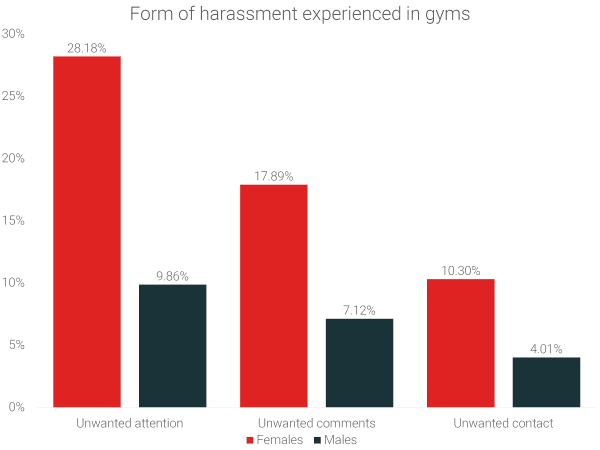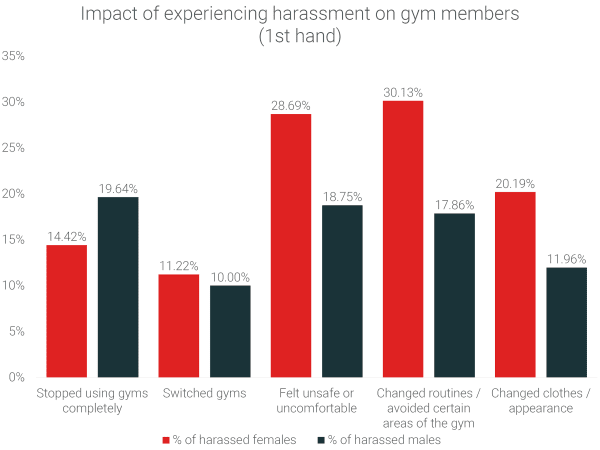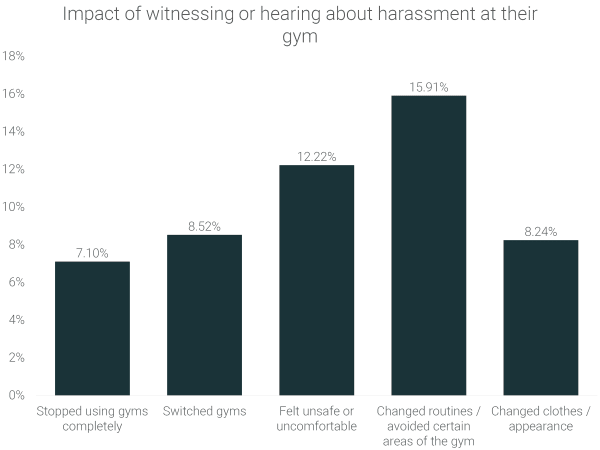The researchers at RunRepeat wanted to understand the prevalence of gym harassment and how it impacts members, gyms, and the industry as a whole. To investigate this we surveyed 3,774 gym members (1107 female and 2667 male) in June of 2021.
READ ALSO: Top 50 fittest cities in Arizona
Key Findings
• 56.37% of female gym members have experienced harassment at the gym – 2.68x more than male gym members (21.00%)
• 92.31% of cases of harassment against females go unreported
• Of the female gym members who experienced being harassed:
– 25.65% stopped using gyms completely or switched gyms
– 28.69% felt unsafe or uncomfortable at their gym
– 30.13% changed their gym routine, schedule, or avoided certain areas at the gym
– 20.19% changed their clothes or appearance when going to the gym
Gym harassment prevalence
More than half of female gym members have experienced harassment at the gym (56.37%).
This issue is 2.68 times as prevalent for female members as only 21% of male members were harassed at the gym.

These instances of harassment at gyms are not isolated events – impacting only those directly involved.
When female members were asked, 12.83% said they witnessed harassment occur and 14.54% heard of harassment at their gym from someone else.

Female gym members are also less likely to report their harassment. Only 7.69% of harassed female respondents reported their harassment in comparison to the 10.00% of harassed male gym members.
With gym harassment going largely unreported, it only amplifies this issue as it means gyms are not actively addressing these instances that their members experience.
Form of harassment members experience in gyms
Members also responded with which of the three forms of harassment they experienced.
We found that out of all female gym members:
• 1 out of 4 experienced unwanted attention
• Nearly 1 out of 5 receive unwanted comments
• 1 out of 10 experience unwanted physical contact

These issues disproportionately impact female gym members.
In comparison to male gym members, female members are:
• 2.85x more likely to experience unwanted attention
• 2.51x more likely to experience unwanted comments
• 2.57x more likely to experience unwanted physical contact
Gym harassments impact on gym members
Gym harassment is a major retention issue for the gym industry as a whole.14.42% of females and 19.64% of males who experience harassment stopped using gyms completely.
As for individual gym retention, a tenth of members that are harassed switch to a different gym.

While males that are harassed are more likely to stop using gyms completely or switch gyms, females harassed at the gym are:
• 1.53x more likely to feel unsafe or uncomfortable
• 1.69x more likely to change gym routines and avoid certain areas of the gym
• 1.68x more likely to change their clothes or appearance when going to the gym
The impact of these incidents doesn’t stop with just those that are directly involved. More than 50% of members who have witnessed or heard of harassment at their gym say it negatively impacts them.

In fact, respondents who have never experienced gym harassment but have witnessed or heard about it are 15.63% more likely to to cancel their membership.
Just knowing of harassment at their gym made 12.22% of members feel unsafe or uncomfortable. Leading to behavioral changes where many members alter their gym routine, avoid certain areas at the gym, change their clothes or appearance.
Conclusion
Harassment is a prevalent issue in gyms – one that disproportionately impacts female gym members.
Being harassed leads to people feeling unsafe, uncomfortable, to alter their behavior, and cancel memberships. Not only that, anyone that sees that incident or hears about it from someone else are impacted as well.
Despite how many experience this issue, less than tenth of members report their harassment.
It’s the responsibility of studios, health clubs, and the likes to provide a safe environment for members to workout and enjoy the benefits of exercise.
They need to ensure they are working to raise awareness, lower the rate of harassment, increase the rate of those that report, and effectively handle these incidents in order to combat gym harassment.




